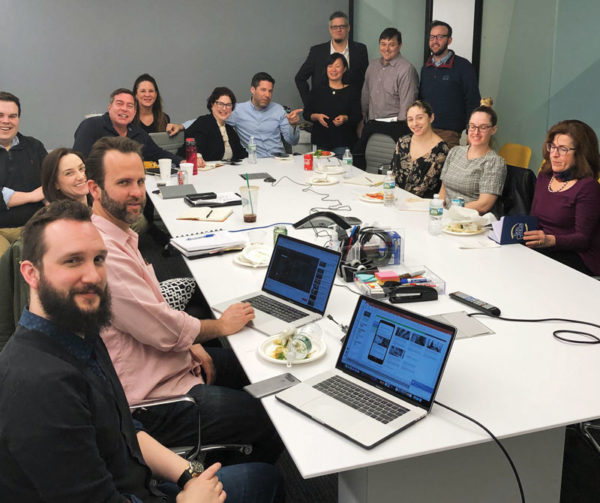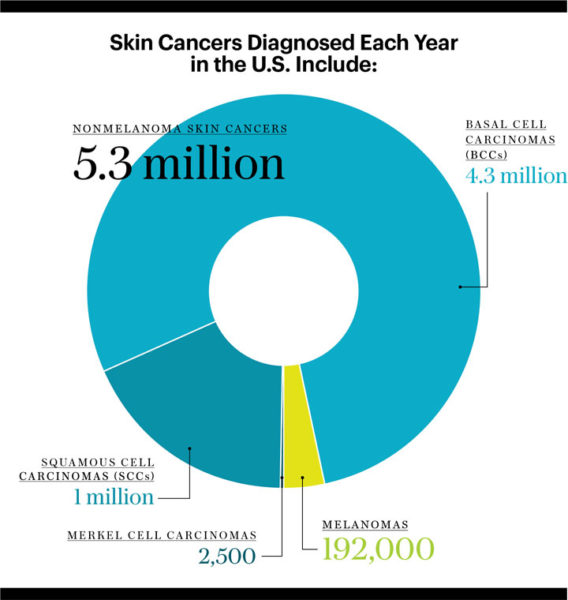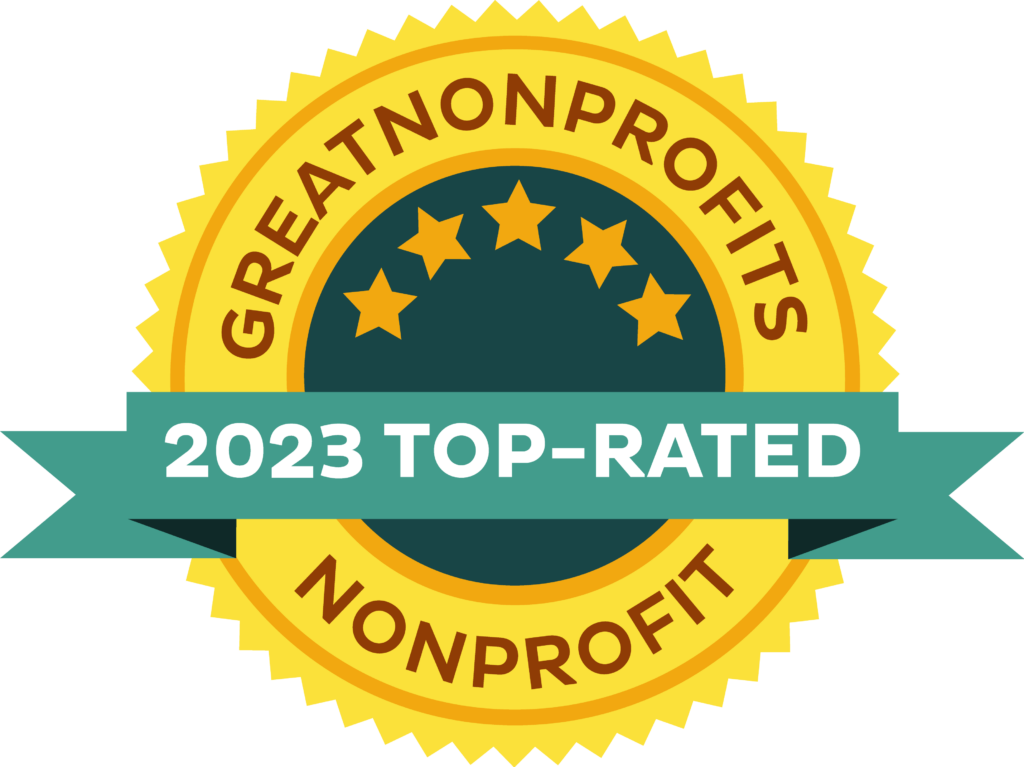The Skin Cancer Foundation’s ad campaign, The Big See®, motivates you to look at yourself in the mirror with a simple new focus that could save your life.
By Julie Bain and Becky Kamowitz
At The Skin Cancer Foundation, we know how difficult it is to transform complicated medical information into materials that are easy for anyone to understand and use. Skin cancer is the most common cancer in the world. But it wasn’t simple in 1979, when The Skin Cancer Foundation was founded, to be the lone voice in a sun-worshipping world, trying to raise awareness about how radiation from the sun damages your skin and can lead to skin cancer. We were the first to preach the gospel of sun protection, even when nobody was very excited to hear it.
In the decades since, we’ve worked hard to educate the public about the various types of skin cancer, providing statistics about each, plus detailed, up-to-date, medically reviewed information about prevention, warning signs, early detection, diagnosis and treatments. That has required a lot of big words, and a lot of effort to simplify, explain and engage with readers and empower them to take action. Millions of people have read articles on our website, on this blog, in our magazine and in our brochures in doctors’ offices. We know we have helped people and made a difference.
And yet … because of all the sun damage that happened years, even decades, ago, skin cancer cases have continued to increase dramatically. In the past decade, the number of new invasive melanoma cases diagnosed annually in the U.S. increased by 54 percent. Between 1994 and 2014, the diagnosis of nonmelanoma skin cancers in the U.S. increased by 77 percent. Experts agree this is an epidemic. We want to move past the prevailing myth of “It’s just skin cancer” and help people understand that when detection and treatment are delayed, there can be serious physical, emotional and monetary costs.
Seeking a Simpler Message
As we celebrate the Foundation’s 40th birthday this year, we know we’re no longer the lone voice preaching the gospel of sun protection. Today, people are overwhelmed with more information than they could ever consume. Prevention is crucial, of course, and will always remain a key part of our message. But we determined that we can set ourselves apart and make a big difference by focusing more on early detection and treatment — and how it starts with you. We want to make sure you have the knowledge and tools to start the process, as we unveil our major new campaign with a simple new message.
How did we get there? The “keep it simple” bell rang for us one day late in 2017. We were updating our brochure on early detection, which focused mainly on the ABCDEs of melanoma. And we started asking, “Why?” While about 192,000 cases of melanoma are diagnosed in the U.S. each year, more than 5 million cases of the so-called “nonmelanoma skin cancers” are diagnosed in the U.S. each year. Glance at our pie chart and you’ll see why we had a eureka moment.
Awareness of melanoma is important, because it is more likely to spread and become life-threatening. But the more common cancers can affect quality of life and, in some cases, threaten life, too. We don’t want people to think these cancers are no big deal. The latest figures suggest, in fact, that more than twice as many people (over 15,000) die in the U.S. each year from squamous cell carcinoma of the skin than from melanoma (7,230). For too long, we believe, BCCs and SCCs have been dangerously downplayed as “cancers you can just cut off.” Our mission is to give these cancers the serious attention they deserve.
Skin Cancer Is the Cancer You Can SEE.
Identifying possible skin cancers is a visual process, and you and your dermatologist can both see your skin. You’re the one who lives in it, sees it daily and knows it best. Skin cancers are not one size fits all. Many melanomas and most nonmelanoma skin cancers don’t fall under the ABCDE pattern. When we educate people about the warning signs of skin cancer, we often hear from them, “Mine didn’t look like that.”
Deborah S. Sarnoff, MD, president of the SCF, was in the office with us one day, and she said something that stuck with us. “Well, really, anything on your skin that’s new, changing or not healing should be checked out.” As we talked that through, she added, “or anything that just doesn’t seem right to you.” She said she often hears from patients that they noticed a spot that just looks weird or unusual to them, and it nags at them till they trust their gut and mention it to her. Often those prove to be skin cancers.
We decided that if we wanted to make a bigger impact on saving and improving lives, we needed to create a simple way to empower people to take a proactive approach to the early detection of skin cancer. It was time to change the conversation from, “You need to be on the lookout for these specific symptoms for each different type of skin cancer” to something easy and impactful. Less is more. Since most skin cancers are curable if caught early enough, the right motivation to get checked and treated ASAP could lead to fewer deaths.
When we educate people about the warning signs of skin cancer, we often hear from them, “Mine didn’t look like that.”
So, we knew it was time to try something new, and we knew what we wanted to say. But how would we get to the people who needed to hear what we had to tell them?
Enter Publicis Health.
As we were developing ideas for a new campaign, the Corporate Social Responsibility team at Publicis Health (a communications network with about a dozen creative agencies worldwide) was looking for a cause to support. The CSR team surveyed employees to find an issue that was important to them and landed on skin cancer. Many employees had a personal connection to the disease — including Sue Manber, chief strategy officer for Digitas Health (one of the agencies under the Publicis network). The partnership was deeply personal to Sue, who on New Year’s Eve 2013 was diagnosed with a rare and aggressive form of skin cancer. It can have a dire prognosis if it has spread.

Sue Manber (at far end of table in glasses), and the team at Digitas shared ideas with our SCF marketing team. Photo credit: Dan Latore
“As a survivor of Merkel cell carcinoma, I am extremely passionate about helping to raise awareness of the importance of protection against and early detection of skin cancer,” she says. “I will forever be grateful to my daughter, Sarina, for asking me, ‘Mom, what’s that thing on your nose?’ Had I ignored her, even for a few weeks, I wouldn’t be here today. My personal mission is to do everything in my power to help more people prevent and detect skin cancer, and ultimately, to end death from skin cancer.” Sue asked us how she could help, and we told her about our hopes for a new campaign.
Introducing … The Big See!

The perfect tool to help you do this is a mirror. Luckily, mirrors are everywhere: at home, in stores, at the gym. We want to take over mirrors across the country and place a branded, reflective “mirror cling” on as many mirrors as we can reach. Through these clings, we’ll empower people to perform skin checks and tell them what to look for in a simple and all-encompassing way. Everywhere there’s a mirror, there’s our message: “What’s that?” It’s short, simple and grabs your attention.
We’re also thrilled to announce our Big See TV commercial. The commercial includes an interactive talking mirror that engages people while motivating them to go get checked by a dermatologist. The Big See campaign also includes a website, social media effort and print advertisements.
Be sure to keep an eye out for The Big See and the big C — and help us save lives!
Julie Bain is senior director of science & education at The Skin Cancer Foundation.
Becky Kamowitz is senior director of marketing communications at The Skin Cancer Foundation.







